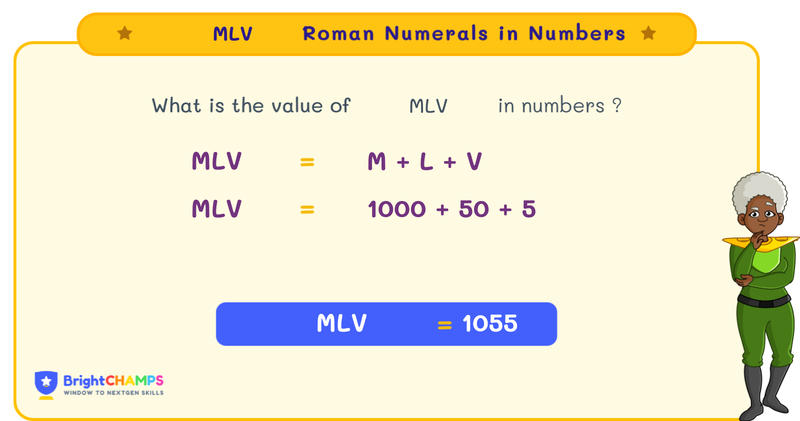
 167 Learners
167 LearnersLast updated on May 26th, 2025

MLV in Roman Numerals

To meet their daily commerce and administration needs, the ancient Romans developed Roman Numerals. It used a combination of seven symbols — I, V, X, L, C, D, and M to represent numbers. Roman numerals were used to record transactions, keep track of data, and label military units. In this topic, we are going to learn about the Roman numeral MLV.
What is MLV in Roman Numerals?
Ancient Romans discovered that counting fingers could get very complicated after 10. So to overcome the complexity, the Roman numeric system was developed. This was widely used throughout Europe as a standard writing system until the late Middle Ages.
Seven symbols are used to represent numbers in the Roman numeric system — I, V, X, L, C, D, and M. The numerals are made up of different combinations of these symbols.
MLV in Roman numerals can be written in number form by adding the values of each Roman numeral, i.e. MLV = 1055. Let us learn more about the Roman numeral MLV, how we write them, the mistakes we usually make, and ways to avoid these mistakes.

Basic Rules for MLV in Roman Numerals
When writing Roman numerals, there are a few rules that we need to follow based on the Roman numerals we are trying to write. In this section, we will learn about the rules when writing Roman numerals and how to represent them.
Rule 1: Addition Method:
When a larger symbol is followed by a smaller symbol, we add the numerals to each other. For example, in VI, we have 5 + 1 = 6.
Rule 2: Repetition Method:
A symbol that is repeated three times in continuation increases the value of the numeral. For example, XXX = 30.
Rule 3: Subtraction Method:
We use the subtraction method when a larger symbol follows a smaller symbol. For example, XL = 40 (which is 50 – 10).
Rule 4: Limitation Rule:
Symbols cannot be repeated more than three times, and some symbols, such as V, L, and D, cannot be repeated more than once. For example, 10 is represented as X and not VV.
How to Write MLV in Roman Numerals?
Let us learn about how to write MLV in Roman numerals. There are two methods that we can use to write Roman numerals:
- By Expansion Method
- By Grouping Method
MLV in Roman Numeral by Expansion Method
The breaking down of Roman numerals into parts and then converting them into numerals is what we call the expansion method. The expansion method is the breaking down of Roman numerals into numerical form and adding them to get the final number.
Step 1: Break the Roman numerals into parts.
Step 2: Now write each of the Roman numerals with its numerical digit in the place value.
Step 3: Add the numerals together.
For MLV,
Step 1: First we break the Roman numerals. MLV = M + L + V
Step 2: Write the Roman Numerals for each part
The Roman Numeral M is 1000
The Roman Numeral L is 50
The Roman Numeral V is 5
Step 3: Combine all the numbers M + L + V = 1000 + 50 + 5 = 1055.
Therefore, the Roman Numeral MLV is 1055.
MLV in Roman Numeral by Grouping Method
Using subtraction and addition rules, we will apply the grouping method. This means we break the Roman numerals into smaller groups, which makes it easier to work with. This method groups the Roman numerals logically, and then we write the numbers for each group.
Step 1: Take the largest number and write the number for that Roman numeral.
Step 2: Write the Roman numeral using the subtraction and addition rules.
Example: Let’s take the Roman numeral MLV.
Step 1: The larger Roman numerals are what we will begin with. Once split, the Roman numerals we get are M, L, and V. The numeral for M is 1000
Step 2: Now we need to either add or subtract the smaller number, depending on its place. Here we add L and V to M, and we will get MLV. The Roman numeral L is 50 The Roman numeral V is 5
Therefore, the numeral of MLV is 1055.

Common Mistakes and How to Avoid Them in MLV Roman Numerals
Students can make mistakes when studying Roman numerals. Here are a few common mistakes students make, and ways to avoid them.

MLV Roman Numerals Examples

Problem 1
A historian finds an ancient inscription: MLV + CXX. Calculate the sum and express it in Roman numerals.

The sum is MCLXX
Explanation
Convert both Roman numerals into their decimal form
MLV = 1055
CXX = 120
Now add both numbers: 1055 + 120 = 1175
Now convert the number into Roman numerals. 1175 = 1000 (M) + 100 (C) + 70 (LXX) + 5 (V) = MCLXX

Problem 2
A treasure map mentions the number MLV and instructs to subtract LXX. What is the result in Roman numerals?

The result is MLXV
Explanation
Convert the Roman numerals into their decimal form:
MLV = 1055
LXX = 70
Now subtract the numbers, 1055 - 70 = 985
Convert the number into Roman numerals, 985 = 1000 (M) - 10 (X) + 70 (LXX) + 5 (V) = MLXV

Problem 3
A Roman engineer divides a column height represented by MLV into 5 equal parts. What is the height of one part in Roman numerals?

CCXI
Explanation
Convert MLV into its decimal form
MLV = 1055
Divide by 5 1055 / 5 = 211
Write 211 in Roman numerals: 211 = 200 (CC) + 10 (X) + 1 (I) = CCXI

Problem 4
An ancient Roman architect recorded the area of a rectangular plaza as MLV square feet. If the length is XXV feet, what is the width in Roman numerals?

XLII
Explanation
Write MLV and XXV in numbers
MLV = 1055
XXV = 25
Divide the area by the length to find the width, 1055 / 25 = 42.2 (rounded down to 42 for Roman numeral representation)
Convert 42 into Roman numerals, 42 = 40 (XL) + 2 (II) = XLII

Problem 5
Convert MLV into its decimal form.

In decimal form, MLV is 1055
Explanation
Break MLV into components,
M = 1000
L = 50
V = 5
Add values: 1000 + 50 + 5 = 1055


FAQs on MLV in Roman Numerals
1.What is LV in Roman numerals?
2.Is MLV a prime number?
3.What is MLV + MLV?
4.What is MLL?
5.Subtract LV from MLV
6.How can children in Qatar use numbers in everyday life to understand MLV in Roman Numerals?
7.What are some fun ways kids in Qatar can practice MLV in Roman Numerals with numbers?
8.What role do numbers and MLV in Roman Numerals play in helping children in Qatar develop problem-solving skills?
9.How can families in Qatar create number-rich environments to improve MLV in Roman Numerals skills?
Important Glossaries for MLV in Roman Numerals
- Limitation Rule: There are some symbols that cannot be repeated more than once (V, L, D). For example, LVV for 60 is wrong; the correct answer is LX.
- Place value: The position of a digit in a number; this position determines its value. For example, the number 5 in 1055 is in the unit's place.
- Subtraction Method: A method used when a smaller numeral precedes a larger one, indicating subtraction. For example, IX for 9.
- Addition Method: A method used when numerals are added together, typically when larger numerals precede smaller ones. For example, VI for 6.
- Expansion Method: A technique in which Roman numerals are broken down into their constituent parts for easier calculation, such as MLV being M + L + V.
Explore More numbers


Hiralee Lalitkumar Makwana
About the Author
Hiralee Lalitkumar Makwana has almost two years of teaching experience. She is a number ninja as she loves numbers. Her interest in numbers can be seen in the way she cracks math puzzles and hidden patterns.
Fun Fact
: She loves to read number jokes and games.




